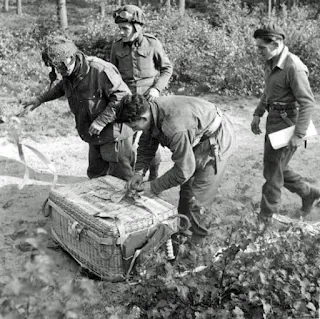It is debatable as to what
effect on the overall outcome of the battle it would have had, but to the best
of my knowledge, contingency planning for the resupply of the British 1st
Airborne Division once on the ground at Arnhem and Oosterbeek, was severely
lacking. By that I mean revision and reconfiguration of the supply drop
scheduling, navigational coordinates, and drop contents, due to actual
troop positions/situations as the battle evolved, and the requisite
communications plans necessary to affect those changes. Documented planning
considerations did include alternative dropping and landing zones being
selected beforehand (whether they were or not is unknown to the author), but no such provisions for resupply. A principal reason
for this is that the doctrine and planning for the employment of airborne
troops at that time, was that they were "intended to fight not more than three
days unsupported by other troops". Note the paucity of guidance regarding resupply in the totality of planning documentation found in; http://arnhemjim.blogspot.com/p/operation-market-garden.html.
There is an excellent book, “ARNHEM THE FIGHT TO SUSTAIN”, The Untold
Story of the Airborne Logisticians, Brig. F. Steer (ROC- Rtd.), Leo Cooper,
South Yorkshire, 2000, ISBN 0 85052 770 8, which covers virtually every aspect of
logistics, before and during Operation Market-Garden. It relates how many aspects of resupply were considered. It does not however include any mention of provisions being made for the dynamics of the evolving battle, and the
resultant effects on changing logistical requirements and revised routing (navigational coordinates) of resupply aircraft
sorties.
The following tables, reproduced with acknowledgment and gratitude to Brig. Steer's book, provide a summary of the results of this critical element of the planning:
In his after-action report MGEN
R.E. ‘Roy’ Urquhart relates,” We had tried to get messages back by every means
to prevent the airmen from dropping their loads in the scheduled places which were
in German hands. We had sent co-ordinates of the places they should try to put
the stuff down. Hopefully, as the Dakotas came on, we watched for the the first
sign that that the pilots were aware, by order or by observation, of the
situation. Again, the ground signals were laid and lit, and the troops held out
parachute silks. But the aircraft kept to the planned dropping points and the
Germans again found themselves receiving gifts from their enemies. Only the
overs reached us. Some crews, overshooting, came round in the face of most
appalling flak. Some aircraft were on fire. Hundreds of us saw one man in the
doorway of a blazing Dakota refusing to release a pannier until he had found
the exact spot, though the machine was a flaming torch now and he had no hope
of escape.”
Rather than rely only on
pre-planned resupply drop co-ordinates and schedules, and solely radio communications
to convey requests for any modifications, additional alternative means of
communication should have been incorporated into the communications and resupply
annexes to the Divisional Operation Order. To the best of the author’s
knowledge this was not done. The resupply aircraft were delivering the CLE canisters
and panniers at a 1000-foot altitude. Visual signaling devices could certainly
have been pre-arranged and employed. These could have included; Very pistols, colored
flares, smoke candles and grenades (in pre-designated colors or combinations), issued
yellow Celanese and/or white marking panels, even the signal lights employed by
the pathfinders of the XXI Independent Parachute Company.
The next group of photographs were taken in the immediate vicinity of the Hartenstein Hotel in Oosterbeek, which can be seen in the second photograph.
The next group of photographs were taken in the immediate vicinity of the Hartenstein Hotel in Oosterbeek, which can be seen in the second photograph.
As it was, many of these devices were employed, and as can be seen in the above photographs extensive
improvisation of various means of visual communications were employed, but under
no known structured plan. The result was a very high casualty rate amongst the RAF
resupply aircraft and personnel (309 aircrew and 79 Air Dispatchers were killed and 107 aircraft lost), lack of adjusted structure and priorities to deliveries
beyond initial planning, significant personnel and material casualties on the ground in
attempting to retrieve containers, and the bottom line being a totally unacceptable
low percentage of supplies recovered. Ground casualties were particularly heavy within personnel of the 250th (Airborne) Light Composite Company of the Royal Army Service Corps, which had a primary assignment of retrieving the air dropped supplies, and establishing/maintaining the Divisional Administrative Area (DAA). This overall situation resulted in a critical lack of basic rations, and perhaps even more importantly, ammunition
for all weaponry, from 17 pdr to75mm, all the way down to .303cal. and 9mm. The
total amount of supplies reported to have been retrieved was 106 tons (with as much as a possible additional 100 tons not officially confirmed and recorded), 7.4% of what was dropped
during the entire operation. See the following table, again with acknowledgement and gratitude to Brig. Steer's book:
If interested, the reader can scroll down in the following blog page; http://arnhemjim.blogspot.com/2012/10/the-polsten-20mm-gun-at-operation.html , and they will find a particularly poignant and tragic true story regarding the resupply at the Battle of Arnhem. It is complete with a copy of the actual War Diary page from the 1st Airborne Reconnaissance Squadron, Royal Ordnance Corps, which establishes its veracity.









No comments:
Post a Comment